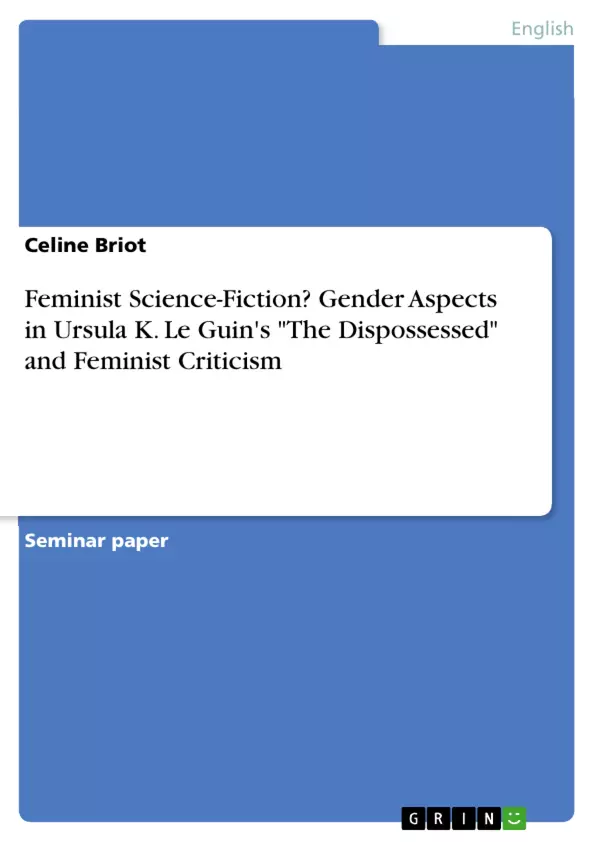In recent decades the literary genre of Science Fiction has experienced a rising interest which might be attributed to the rapid technological development and the deep integration of it into daily life.
Science Fiction offers writers a wide range of potential themes to explore and is thus a very complex genre.
While often being considered male oriented, at least during the Feminist Movement in the 1960s, female authors found their way into the genre and raised questions about gender roles, political inequality and sexuality within their works.
Among those female writers was Ursula K. Le Guin who gained wide recognition for her writing and is today regarded one of the most influential science-fiction and fantasy author of the twentieth century.
Asscociated with feminist tendencies in her works, her most famous novel referred to be feminist science fiction is "The Left Hand of Darkness" in which she imagined an androgynous society in order to investigate what society would be if sex did not matter.
But also many other of her works have received attention from critics interested in gender and feminism.
In this paper I intend to analyse and discuss the depiction of gender and the realisation of feminist aspects in Le Guin's novel "The Dispossessed: An ambiguous Utopia".
The novel won several important literary awards such as the Hugo and the Nebula and gained a lot of respect among critics for its great literary qualities and its extensive exploration of political ideas and social themes, including for example anarchism, capitalism and socialism.
It is set on the fictional planets Urras and Anarres which inhabit two contrasting societies, one capitalist and class oriented and the other one following the principles of anarchism, avoiding any form of social hierarchy among its population.
Anarres – apparently the utopian planet in Le Guin's work, is often called a feminist utopia for its conception of gender. However, Le Guin has been highly criticised from feminist for several problematic issues in her approach of sexual politics in the novel.
The question therefore arises weather "The Dispossessed" really can be labeled feminist science-fiction and if Anarres really can be called a feminist utopia?
Inhaltsverzeichnis (Table of Contents)
- Introduction
- Defining Feminism
- Liberal and Radical Feminism
- Gender in The Dispossessed
- Gender Concept on Anarres
- Gender Concept on Urras
- Feminist Criticism of The Dispossessed
- Conclusion
Zielsetzung und Themenschwerpunkte (Objectives and Key Themes)
This paper analyzes the portrayal of gender and feminist aspects in Ursula K. Le Guin's novel The Dispossessed: An Ambiguous Utopia. The paper examines the gender concepts and opportunities for women in the societies of Urras and Anarres, specifically focusing on the utopian society of Anarres. It explores the arguments of feminist critics regarding the novel's approach to gender equality and the potential ambiguity in its realization of feminist ideals.
- Gender roles and equality in utopian societies
- Feminist perspectives on science fiction
- The portrayal of anarchism and its impact on gender relations
- The concept of gender neutrality and its implications
- Critical analysis of feminist ideals in literary works
Zusammenfassung der Kapitel (Chapter Summaries)
The introduction explores the rising interest in science fiction and its potential for examining gender roles and social inequality. It highlights Ursula K. Le Guin's significant contributions to feminist science fiction, particularly through her novel The Left Hand of Darkness. The paper focuses on analyzing the depiction of gender in The Dispossessed, examining its potential for feminist interpretation.
Chapter 2 defines feminism and its different orientations, emphasizing liberal and radical feminism. It outlines the key differences between these movements, focusing on their approaches to gender equality in the public and private spheres.
Chapter 3 delves into the gender concepts present in The Dispossessed, specifically examining the society of Anarres. It explores the Odonian philosophy, emphasizing egalitarianism, solidarity, and the absence of social hierarchy. The chapter discusses the irrelevance of gender in Anarres, as seen in the use of unique names and the distribution of work based on ability and community needs.
Schlüsselwörter (Keywords)
The main keywords and focus topics of this paper include feminist science fiction, gender roles, utopian societies, anarchism, egalitarianism, gender neutrality, radical feminism, liberal feminism, The Dispossessed, Ursula K. Le Guin, and Odonian philosophy.
- Quote paper
- Celine Briot (Author), 2015, Feminist Science-Fiction? Gender Aspects in Ursula K. Le Guin's "The Dispossessed" and Feminist Criticism, Munich, GRIN Verlag, https://www.grin.com/document/303846



